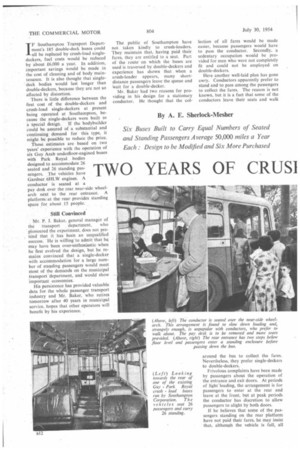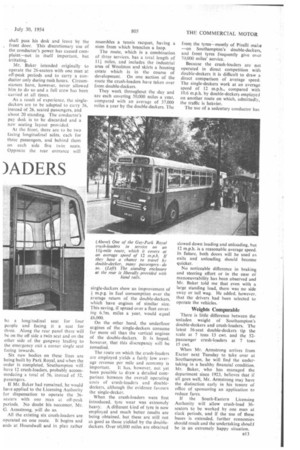TWO YEARS OF CRUSI
Page 46

Page 47

If you've noticed an error in this article please click here to report it so we can fix it.
around the bus to collect the fares. Nevertheless, they prefer single-deckers to double-deckers.
Frivolous complaints have been made by passengers about the operation of the entrance and exit doors. At periods of lightioading, the arrangement is for passengers to enter at the rear and leave at the front, but at peak periods the conductor has discretion to allow passengers to alight by both doors.
If he believes that some of the passengers standing on the rear platform have not paid their fares, he may insist that, although the vehicle is full, all be a longitudinal seat for four people and facing it a scat for three. Along the rear panel there will he on the off side a twin seat and on the other side of. the gangway leading to the emergency exit a corner single seat facing inwards.
Six new bodies on these lines are being built by Park Royal, and when the order is completed, Southampton will have 12 crush-loaders, probably accommodating a total of 56, instead of 52, passengers.
If Mr. Baker had remained, he would have applied to the Licensing Authority for dispensation to operate the 36seaters with one man at off-peak periods. No doubt his successor, Mr. G. Armstrong, will do so.
All the existing six crush-loaders are operated on one route. It begins and ends at lloundwell and in plan rather single-deckers show an improvement of m.p.g. in fuel consumption over the average return of the double-deckers, which have engines of similar size. This saving, if spread over a fleet covering 6.5m. miles a year, would equal £6,000.
On the other hand, the underfloor engines of the single-deckers consume far more oil than the vertical engines of the double-deckers. It is hoped, however, that this discrepancy will be remedied.
The route on which the crush-loaders are employed yields a fairly low average revenue per mile and economy is important. It has, however, not yet been possible to draw a detailed comparison between the overall operating costs of crush-loaders and doubledeckers, although the evidence favours the single-decker.
When the crush-loaders were first introduced, tyre wear was extremely heavy. A different kind of tyre is now employed and much better results are being obtained, but these are still not as good as those yielded by the doubledeckers. Over 60,000 miles are obtained slowed down loading and unloading, but 12 m.p.h. is a reasonable average speed. In future, both doors will .be used as exits and unloading should become quicker.
No noticeable difference in braking and steering effort or in the ease of manoeuvrability has been observed and Mr. Baker told me that even with a large standing load, there was no side sway or tail wag. He added, however, that the drivers had been selected to operate the vehicles.
• Weights Comparable
There is little difference between the unladen weight of Southampton's double-deckers and crush-loaders. The latest 56-seat double-deckers tip the scale at 7 tons 13 cwt. and the 52passsenger crush-loaders at 7 tons 15 cwt.
When Mr. Armstrong arrives from Exeter next Tuesday to take over at Southampton, he will find the undertaking in a healthy financial condition. Mr. Baker, who has managed the department since 1923, believes that if all goes well, Mr. Armstrong may have the distinction early in his tenure of office of sponsoring an application to reduce fares.
If the South-Eastern Licensing Authority will allow crush-load 36seaters to be worked by one man at slack periods, and if the use of these buses is extended, further economies should result and the undertaking should be in an extremely happy situation.




















































































